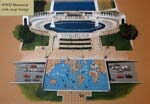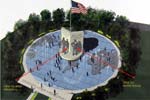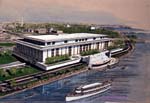
|

|
|
Home Site Search Contact Us Subscribe
|
|
Arthur Cotton Moore: Bold Citizen-Architect Some of the ideas seem impractical. Others would be ruinously expensive. Still others are sensible and ought to be considered, or at least admired for their audacity. A sampling from Moore's new book, "Our Nation's Capital: Pro Bono Publico Ideas." By Fred A. Bernstein December 14, 2017 Arthur Cotton Moore is a sixth-generation Washingtonian with an intense love for the city, as well as an intense awareness of its faults. Since becoming an architect in 1965, he has followed two separate career paths: one, carrying out jobs for clients, including a major renovation of the Library of Congress; the other, proposing bold civic improvements. The latter preoccupation, Moore writes in his new book, Our Nation’s Capital: Pro Bono Publico Ideas (International Arts and Artists, 2017), compiled largely by his wife Patricia Moore, was carried out with “no clients, no compensation by money or favor, and no pursuit of architectural commissions.” In other words, nothing to rein in his fertile imagination.
Some of the ideas seem impractical (he proposed moving the Supreme Court to an extension of the National Mall, in recognition of its importance to the tripartite system of government). Others would be ruinously expensive.
But a few of Moore’s ideas were prescient: In 1982, he proposed building a broad stairway to connect the Kennedy Center to the Potomac River, from which it was entirely disconnected. A stairway is part of the Steven Holl-designed renovation of the Center currently under construction. (Moore also proposed covering the Center’s flat roof in solar panels; that hasn’t happened.)
Some of Moore’s ideas are sensible and ought to be considered, or at least admired for their audacity. Here are a few:
Model of the Nation’s Capital
Memorial Bridges
To find room for more memorials on the National Mall (and make crossing major avenues safe for pedestrians), Moore proposed building bridges laden with monuments, comparable to the bust-festooned Charles Bridge in Prague.
Ike Monument Near WWII Memorial
The Dwight D. Eisenhower Memorial under construction on Maryland Avenue is overblown, isolated, and confusing. Moore proposed a smaller memorial that, sensibly, would have a visual connection to the World War II Memorial already on the National Mall.
Roof Over I.M. Pei & Partners-designed Church
The 1971 Brutalist Third Church of Christ, Scientist, designed by I.M. Pei & Partners’ Araldo A. Cossutta, was demolished in 2014. It could have been saved (and a new public plaza created) if developers had followed Moore’s plan to construct an office building above the church.
A Train That Never Stops
Rail travel on the busy Northeast Corridor would be more efficient if Amtrak adopted Moore’s idea: A monorail at each station would sidle up to passing trains. Departing passengers would move from the monorail to the train, while arriving passengers would move from the train to the monorail; the train itself would continue moving at full speed. Fred A. Bernstein has degrees in architecture (from Princeton University) and law (from NYU) and writes about both subjects.
Also by Bernstein:
In "Building Art: The Life and Work of Frank Gehry," Paul Goldberger's account of the architect's rise is also a tale of things not going Gehry's way.
Since 1931, the Empire State Building has been New York City's GPS, but with spate of supertalls obscuring the building, it could become hard to tell Manhattan from Kowloon or Pudong or Shinjuku or Canary Wharf.
Preservation Alert: P.S. 199, by Edward Durell Stone (1963) The public school on Manhattan's Upper West Side could be facing demolition if developer takes up New York City's offer to sell the site.
Mies built the Farnsworth in spitting distance of the mighty Fox River, and the house is paying price for his hubris.
An Open Letter to Susan Szenasy re: Frank Gehry
Second Look: Pavilion and Colonnade Apartments by Mies van der Rohe, 1960Newark, NJ: Current news about "starchitects" designing high-rise housing in New York is at an all-time high, but Mies did it across the Hudson River 46 years ago.
Second Look: Tracey Towers by Paul Rudolph, 1972 How did Rudolph, restless and challenging architectural mind, end up doing subsidized housing in the Bronx?
Op-Ed: The 2012 New York Olympics is lost. Long live the 2014 New York World's Fair.
Queens, NY: Its power undiminished after 40 years, a 20th century cathedral to science is about to be rediscovered as a luminous addition debuts this week.
Beauty in Garbage: Naka Incineration Plant by Yoshio Taniguchi Hiroshima: An incineration plant is devised as real-time science museum and tourist destination (complete with waterfront park).
Second Look: George Washington Bridge Bus Station / Pier Luigi Nervi, 1963 One of Nervi's few completed projects outside Italy is superb example of the poetry he wrought from ferro-concrete.
|
(click on pictures to enlarge)  ©Arthur Cotton Moore Pavilion near the National Building Museum to house a Panorama of Washington, DC.  ©Arthur Cotton Moore Interior of the Washington, DC, Panorama.  ©Arthur Cotton Moore Concept for a memorial bridge near the World War II Memorial on the National Mall.  ©Arthur Cotton Moore Moore proposed a compact Dwight D. Eisenhower Memorial that would have visual connections to the existing World War II Memorial and the White House.  ©Arthur Cotton Moore A 1982 proposal for a broad stairway to connect the Kennedy Center to the Potomac River.  ©Arthur Cotton Moore The now-demolished I.M. Pei & Partners-designed 1971 Brutalist Third Church of Christ, Scientist could have been saved if developers had followed Moore’s plan to construct an office building above the church.  ©Arthur Cotton Moore Concept for a monorail at Amtrak stations that would sidle up to passing trains. |
© 2017 ArchNewsNow.com